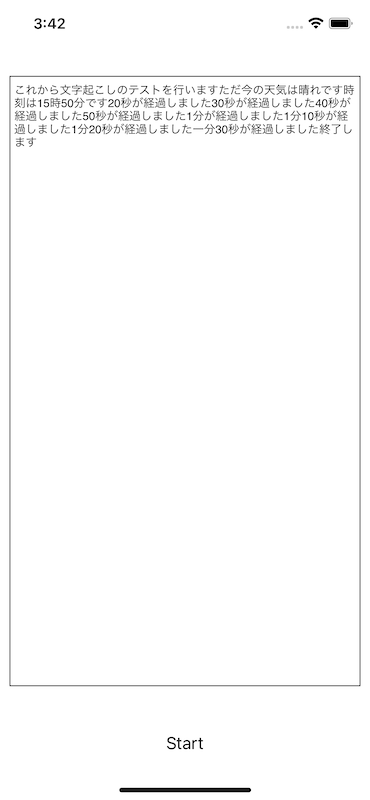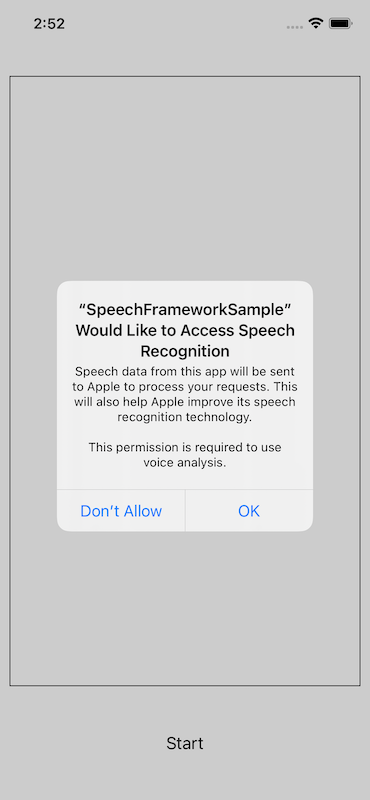今回はSpeech Frameworkを使用して音声ファイルから文字起こしを行ってみます。
環境: Xcode 12.4、Swift 5
Info.plist
まずSpeech Frameworkを使用する許可をユーザーから得る為にInfo.plistにNSSpeechRecognitionUsageDescriptionを追加します。
<key>NSSpeechRecognitionUsageDescription</key>
<string>This permission is required to use voice analysis.</string>
その上でSFSpeechRecognizerのrequestAuthorizationを実行することでユーザーにSpeech Frameworkを使用する許可を求めるダイアログが表示されます。
SFSpeechRecognizer.requestAuthorization { (authStatus) in
}
音声ファイルの分割
さて、早速音声ファイルをSpeech Frameworkで読み込ませたいところですが、ここで一つ留意しなくてはならないことがあります。
この記事の執筆時点(2021年3月28日)ではSpeech Frameworkの使用時間は60秒までに制限されています。
その為、音声ファイルをただ単にSpeech Frameworkに読み込ませるだけだと最初の60秒分しか文字起こしが行われません。
音声ファイルの長さが60秒以上ある場合は、あらかじめ60秒単位で音声ファイルを分割して、それぞれのファイル毎にSpeech Frameworkへの読み込みを行わせる必要があります。
音声ファイルの分割はAVAssetExportSessionで行うことができます。
private var avAudioFile: AVAudioFile!
private var croppedFileInfos: [FileInfo] = []
private var croppedFileCount: Int = 0
private struct FileInfo {
var url: URL
var startTime: Double
var endTime: Double
}
private func cropFile() {
// sample.m4aを60秒単位でcroppedFile_連番.m4aというファイルに分割しLibraryディレクトリ下に配置
if let audioPath = Bundle.main.path(forResource:"sample" , ofType:"m4a") {
let audioFileUrl = URL(fileURLWithPath : audioPath)
do {
self.avAudioFile = try AVAudioFile(forReading: audioFileUrl)
}catch let error{
print(error)
}
let recordTime = Double(self.avAudioFile.length) / self.avAudioFile.fileFormat.sampleRate
let oneFileTime: Double = 60
var startTime: Double = 0
while startTime < recordTime {
let fullPath = NSHomeDirectory() + "/Library/croppedFile_" + String(self.croppedFileInfos.count) + ".m4a"
if FileManager.default.fileExists(atPath: fullPath) {
do {
try FileManager.default.removeItem(atPath: fullPath)
}catch let error {
print(error)
}
}
let url = URL(fileURLWithPath: fullPath)
let endTime: Double = startTime + oneFileTime <= recordTime ? startTime + oneFileTime : recordTime
self.croppedFileInfos.append(FileInfo(url: url, startTime: startTime, endTime: endTime))
startTime += oneFileTime
}
for cropeedFileInfo in self.croppedFileInfos {
self.exportAsynchronously(fileInfo: cropeedFileInfo)
}
}
}
private func exportAsynchronously(fileInfo: FileInfo) {
let startCMTime = CMTimeMake(value: Int64(fileInfo.startTime), timescale: 1)
let endCMTime = CMTimeMake(value: Int64(fileInfo.endTime), timescale: 1)
let exportTimeRange = CMTimeRangeFromTimeToTime(start: startCMTime, end: endCMTime)
let asset = AVAsset(url: self.avAudioFile.url)
if let exporter = AVAssetExportSession(asset: asset, presetName: AVAssetExportPresetPassthrough) {
exporter.outputFileType = .m4a
exporter.timeRange = exportTimeRange
exporter.outputURL = fileInfo.url
exporter.exportAsynchronously(completionHandler: {
switch exporter.status {
case .completed:
self.croppedFileCount += 1
if self.croppedFileInfos.count == self.croppedFileCount {
// 音声ファイルの分割完了 -> Speech Frameworkによる文字起こし開始
DispatchQueue.main.async {
self.initalizeSpeechFramework()
}
}
case .failed, .cancelled:
if let error = exporter.error {
print(error)
}
default:
break
}
})
}
}
private func self.initalizeSpeechFramework() {
Speech Frameworkによる文字起こし
では、いよいよ文字起こしを行ってみたいと思います。
音声ファイルから文字起こしを行う場合はSFSpeechURLRecognitionRequestで音声ファイルを読み込ませます。
private let textView: UITextView = UITextView()
private var speechRecognizer: SFSpeechRecognizer?
private var recognitionRequest: SFSpeechURLRecognitionRequest?
private var recognitionTask: SFSpeechRecognitionTask?
private var speechText: String = ""
private var croppedFileInfos: [FileInfo] = []
private var currentIndex: Int = 0
private func initalizeSpeechFramework() {
self.recognitionRequest = SFSpeechURLRecognitionRequest(url: self.croppedFileInfos[self.currentIndex].url)
let location = NSLocale.preferredLanguages
self.speechRecognizer = SFSpeechRecognizer(locale: Locale(identifier: location[0]))!
self.recognitionTask = self.speechRecognizer?.recognitionTask(with: self.recognitionRequest!, resultHandler: { (result: SFSpeechRecognitionResult?, error: Error?) -> Void in
if let error = error {
print(error)
} else {
if let result = result {
// 文字起こし文をUITextViewに表示
self.textView.text = self.speechText + result.bestTranscription.formattedString
if result.isFinal {
// 音声ファイルの読み込みが終了
self.finishOrRestartSpeechFramework()
}
}
}
})
}
private func finishOrRestartSpeechFramework() {
// Speech Frameworkを停止
self.recognitionTask?.cancel()
self.recognitionTask?.finish()
self.speechText = self.textView.text
self.currentIndex += 1
if self.currentIndex < self.croppedFileInfos.count {
// まだ音声ファイルが残っている場合は次の音声ファイルの文字起こしを開始
self.initalizeSpeechFramework()
}
}
60秒単位に分割した音声ファイルを一つずつSpeech Frameworkに読み込ませています。
音声ファイルの読み込みが終了するとresult.isFinalがtrueになりますので、次の音声ファイルの読み込みに移っています。全ての音声ファイルの読み込みが終わると終了です。
実際に動かすと以下の様に文字起こしが行われました。

サンプルプログラム全文
このサンプルプログラムはGitHubで公開しています。
<?xml version="1.0" encoding="UTF-8"?>
<!DOCTYPE plist PUBLIC "-//Apple//DTD PLIST 1.0//EN" "http://www.apple.com/DTDs/PropertyList-1.0.dtd">
<plist version="1.0">
<dict>
---------------(中略)---------------
<key>NSSpeechRecognitionUsageDescription</key>
<string>This permission is required to use voice analysis.</string>
</dict>
</plist>
import UIKit
import AVFoundation
import Speech
class ViewController: UIViewController {
private let textView: UITextView = UITextView()
private let startButton: UIButton = UIButton()
private var speechRecognizer: SFSpeechRecognizer?
private var recognitionRequest: SFSpeechURLRecognitionRequest?
private var recognitionTask: SFSpeechRecognitionTask?
private var avAudioFile: AVAudioFile!
private var speechText: String = ""
private var croppedFileInfos: [FileInfo] = []
private var croppedFileCount: Int = 0
private var currentIndex: Int = 0
private struct FileInfo {
var url: URL
var startTime: Double
var endTime: Double
}
override func viewDidLoad() {
super.viewDidLoad()
self.textView.backgroundColor = UIColor.white
self.textView.layer.borderWidth = 1
self.textView.layer.borderColor = UIColor.black.cgColor
self.view.addSubview(self.textView)
self.startButton.setTitle("Start", for: .normal)
self.startButton.setTitleColor(UIColor.black, for: .normal)
self.startButton.addTarget(self, action: #selector(self.touchUpStartButton(_:)), for: .touchUpInside)
self.view.addSubview(self.startButton)
SFSpeechRecognizer.requestAuthorization { (authStatus) in
}
}
override func viewDidLayoutSubviews() {
super.viewDidLayoutSubviews()
let width: CGFloat = self.view.frame.width
let height: CGFloat = self.view.frame.height
self.textView.frame = CGRect(x: 10, y: 80, width: width - 20, height: height - 200)
self.startButton.frame = CGRect(x: width / 2 - 40, y: height - 100, width: 80, height: 80)
}
@objc private func touchUpStartButton(_ sender: UIButton) {
self.textView.text = ""
self.speechText = ""
cropFile()
}
private func cropFile() {
if let audioPath = Bundle.main.path(forResource:"sample" , ofType:"m4a") {
let audioFileUrl = URL(fileURLWithPath : audioPath)
do {
self.avAudioFile = try AVAudioFile(forReading: audioFileUrl)
}catch let error{
print(error)
}
let recordTime = Double(self.avAudioFile.length) / self.avAudioFile.fileFormat.sampleRate
let oneFileTime: Double = 60
var startTime: Double = 0
while startTime < recordTime {
let fullPath = NSHomeDirectory() + "/Library/croppedFile_" + String(self.croppedFileInfos.count) + ".m4a"
if FileManager.default.fileExists(atPath: fullPath) {
do {
try FileManager.default.removeItem(atPath: fullPath)
}catch let error {
print(error)
}
}
let url = URL(fileURLWithPath: fullPath)
let endTime: Double = startTime + oneFileTime <= recordTime ? startTime + oneFileTime : recordTime
self.croppedFileInfos.append(FileInfo(url: url, startTime: startTime, endTime: endTime))
startTime += oneFileTime
}
for cropeedFileInfo in self.croppedFileInfos {
self.exportAsynchronously(fileInfo: cropeedFileInfo)
}
}
}
private func exportAsynchronously(fileInfo: FileInfo) {
let startCMTime = CMTimeMake(value: Int64(fileInfo.startTime), timescale: 1)
let endCMTime = CMTimeMake(value: Int64(fileInfo.endTime), timescale: 1)
let exportTimeRange = CMTimeRangeFromTimeToTime(start: startCMTime, end: endCMTime)
let asset = AVAsset(url: self.avAudioFile.url)
if let exporter = AVAssetExportSession(asset: asset, presetName: AVAssetExportPresetPassthrough) {
exporter.outputFileType = .m4a
exporter.timeRange = exportTimeRange
exporter.outputURL = fileInfo.url
exporter.exportAsynchronously(completionHandler: {
switch exporter.status {
case .completed:
self.croppedFileCount += 1
if self.croppedFileInfos.count == self.croppedFileCount {
DispatchQueue.main.async {
self.initalizeSpeechFramework()
}
}
case .failed, .cancelled:
if let error = exporter.error {
print(error)
}
default:
break
}
})
}
}
private func initalizeSpeechFramework() {
self.recognitionRequest = SFSpeechURLRecognitionRequest(url: self.croppedFileInfos[self.currentIndex].url)
let location = NSLocale.preferredLanguages
self.speechRecognizer = SFSpeechRecognizer(locale: Locale(identifier: location[0]))!
self.recognitionTask = self.speechRecognizer?.recognitionTask(with: self.recognitionRequest!, resultHandler: { (result: SFSpeechRecognitionResult?, error: Error?) -> Void in
if let error = error {
print(error)
} else {
if let result = result {
self.textView.text = self.speechText + result.bestTranscription.formattedString
if result.isFinal {
self.finishOrRestartSpeechFramework()
}
}
}
})
}
private func finishOrRestartSpeechFramework() {
self.recognitionTask?.cancel()
self.recognitionTask?.finish()
self.speechText = self.textView.text
self.currentIndex += 1
if self.currentIndex < self.croppedFileInfos.count {
self.initalizeSpeechFramework()
}
}
}
参考文献
Speech | Apple Developer Documentation
SFSpeechURLRecognitionRequest | Apple Developer Documentation
Qiita | 【iOS】Speech Frameworkの実装
Qiita | Swiftでの音声ファイルトリミング(Crop)と結合(Concat)
